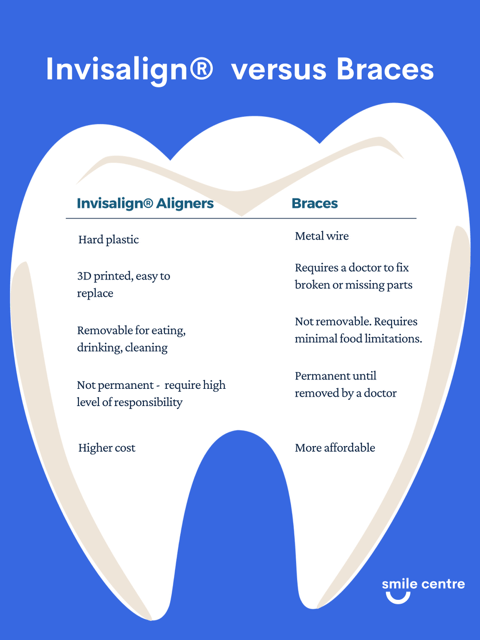
Invisalign Versus Braces - which one is right for your teenager?
When it’s time to help your teenager get straighter teeth, you’ll likely run into a common issue; Invisalign® versus braces; which one is right for your child? The truth is that both have pros and cons, but the ultimate showdown of Invisalign versus braces is one surrounded by loud opinions.
We at the Smile Centre want you to have all the necessary information to get the best choice possible. That’s why we put together a comparison of the two.
Scroll down to see what it really looks like when you put invisible hard plastic up against small wires on a set of teeth.
Let’s start with the basics; what can a set of braces and an Invisalign® aligners plan do for your teen?
What can braces do for teenagers?
Braces are an orthodontic treatment that adds a metal frame around teeth at a young age while the jaw is still malleable. They help crooked, widely-spaced, or overcrowded teeth straighten out and have the right amount of space.
The advantage of braces is years and years of evidence that they work. Patients can rely on them to do their job slowly and without any pain.
Your teenager needs to see a dentist if he or she feels a drop in confidence in his or her smile. This is often an indicator that something is wrong.
Traditional braces can help with an over or underbite, crowding in teeth or an excess of space, even in extreme cases. The metal frame placed around the teeth helps move them slowly and trains them to stay properly aligned.
By the time braces come off, teenagers can have an easier time chewing, speaking, and brushing their teeth. This long-term treatment can also be a huge boost to his or her confidence after the treatment is completed.
Now let’s check out the competition.
What Invisalign® aligners can do for teeth
Invisalign® aligners do a lot of the same things as braces; they help straighten, move, and hold teeth in the right spot. However, Invisalign® aligners do so with more precision and without wires.
Made from hard, BPA-free plastic, Invisalign® aligners are 3D printed from a scan of your teenager’s teeth. Your invisalign expert will use the scan to project how your child’s teeth can shift and change, and then print out a set of aligners to help their teeth gradually move.
Your teenager can take out his or her aligner to eat, drink, or brush their teeth. A lot of teenagers prefer Invisalign® aligners because they’re clear and easy to keep clean.
Of course, there are pros and cons to this approach. Let’s see how they measure up against braces.
Invisalign® versus braces - the ultimate showdown
Here’s a head-to-head comparison of Invisalign® versus braces to help you make an informed decision.

Cost:
Braces and Invisalign® aligners are usually priced similarly. However, traditional braces may require more frequent visits for adjustments, which may lead to additional costs. Additionally, traditional braces may be slightly more expensive if done in a specialist (orthodontist) office.
Maintenance:
While braces mean more visits to the dentist, Invisalign® saves your teen hours. A set of aligners for the next few weeks can be picked up or sent to your home and then placed on the teeth without the help of a professional.
If a wire breaks or needs to be adjusted on your teen’s braces, he or she will have to go to the dentist and have it done professionally.
Limitations
A set of braces means food limitations, though nothing severe. Your teenager will need to avoid popcorn, corn on the cob, sticky candies, and other foods that can leave debris inside the wires.
Invisalign® aligners can come out for mealtimes, so there are no issues with food. They can also come out for a quick clean or to let your teen brush their teeth, while braces require more care.
Convenience:
When it comes to oral health, Invisalign® stands out as the clear winner. With the ability to be easily removed for eating, drinking, and brushing, Invisalign offers a unique advantage over traditional braces. This means no more stressing over what you can and can’t eat, or difficulty flossing and brushing around wires. With Invisalign, you can enjoy all of your favorite foods without worry and keep your teeth and gums healthy with regular brushing and flossing.
Responsibility:
This is where Invisalign® can come up short. Aligners need to be worn 20 to 22 hours a day, but some patients have a tendency to take out their aligners before this time is up.
To help, Invisalign® Teen, a new system for younger patients, has blue indicator dots that help parents check how often aligners get removed. Bold blue indicates the aligners aren’t being used, while faded dots show proper use.
For kids who have a hard time with responsibility, Invisalign® aligners can be difficult. Parents are encouraged to be proactive with kids and help them stay organized so that aligners don’t get lost or go unused.
Make an appointment with an Invisalign certified dentist at Smile Centre today!
Don’t make this decision alone. Consult with a Smile Centre dentist virtually or in person to get more information and better help with your teenager’s oral health. Our passionate team can get you all the best information and insight you need to make this important decision.
Click here to get an appointment.